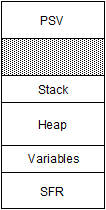Set the end of the process’s data space.
Include
None
Prototype
int brk(void *endds);
Argument
endds |
pointer to the end of the data segment |
Return Value
Returns ‘0’ if successful; otherwise, returns ‘-1’.
Remarks
brk() is used to dynamically change the amount of space
allocated for the calling process’s data segment. The change is made by resetting the
process’s break value and allocating the appropriate amount of space. The break value is
the address of the first location beyond the end of the data segment. The amount of
allocated space increases as the break value increases.
Newly allocated space is uninitialized.
This helper function is used by the Standard C Library function
malloc().
Default Behavior
If the argument endds is zero, the function sets the global
variable __curbrk to the address of the start of the heap and returns
zero.
If the argument endds is non-zero and has a value less than
the address of the end of the heap, the function sets the global variable
__curbrk to the value of endds and returns
zero.
Otherwise, the global variable __curbrk is unchanged and
the function returns -1.
The argument endds must be within the heap range (see data
space memory map below).

Since the stack is located immediately above the heap, using
brk() or sbrk() has little effect on the size of
the dynamic memory pool. The brk() and sbrk()
functions are primarily intended for use in run-time environments where the stack grows
downward and the heap grows upward.
The linker allocates a block of memory for the heap if the
-Wl,--heap=n option is specified, where n is the desired heap size
in characters. The starting and ending addresses of the heap are reported in variables:
_heap and _eheap, respectively.
For the 16-bit compiler, using the linker’s heap size option is the standard
way of controlling heap size, rather than relying on brk() and
sbrk().
File
brk.c